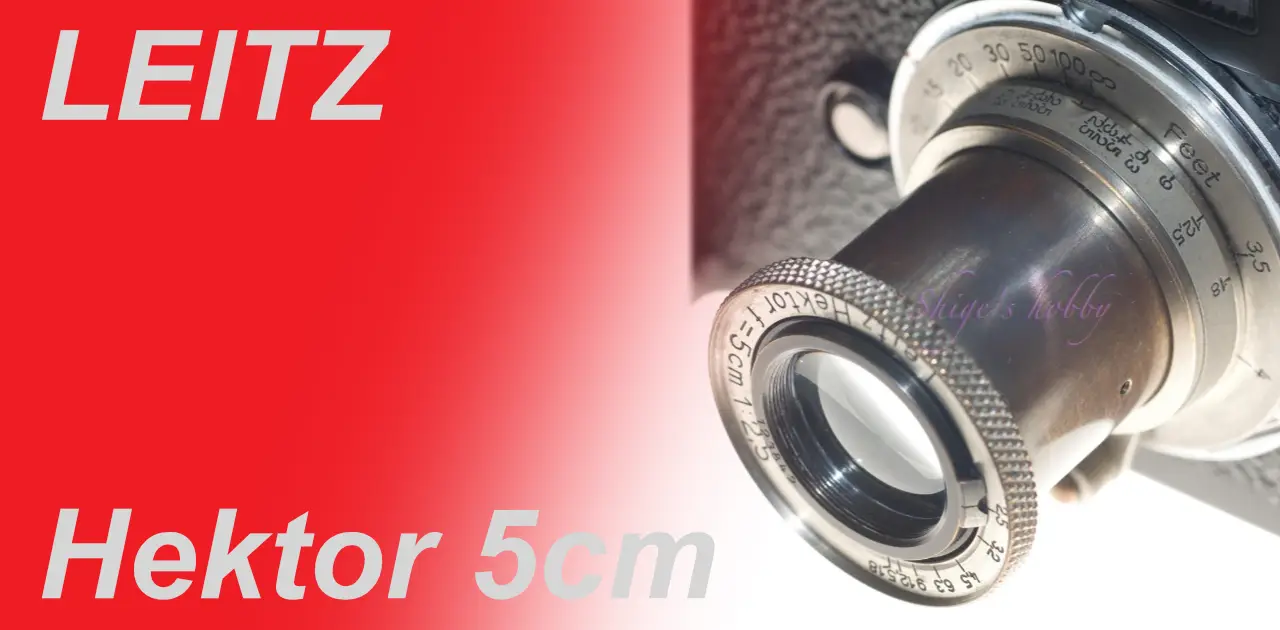Last updated on 2025-09-27
A review and Photo example of the LEITZ HEKTOR 5cm F2.5.
- Please see the disclaimer regarding advertising here.
- Italicized links in the text are advertisement links that take you to other sites.
Table of contents

Gallery
The sample photo were taken with the LEICA M9
Review
1.Overview
The LEITZ HEKTOR 5cm F2.5 is a standard lens released by Leitz (Leica) in 1930.
The main specifications are as follows, and details are listed in the table.
- Aperture value: 2.5
- Lens construction: 6 elements in 3 groups
- Aperture blades: 6
- Minimum focusing distance: 1.0m
- Leica M rangefinder camera rangefinder coupling: 1.0m
- Hood: FIKUS or cover hood
2.Usability
While there are minor differences among LEITZ HEKTOR 5cm F2.5 lenses, the one I owned had a focus ring that rotated almost the entire circumference, distance measurements in feet, and a serial number of 12xxxx, indicating it was made in 1932. The slim lens barrel is a good match for digital Leica cameras and doesn’t obstruct the viewfinder, which is a blessing. The focus ring is located at the base of the lens, making it a bit tricky to use on an M-series Leica; a Barnack Leica would likely be more suitable. The aperture ring, like the old Elmar 50mm, has a control at the tip, which isn’t particularly user-friendly. The lens is retractable, but I never carried it retracted for fear of accidentally hitting the sensor or the internal wall.
When I used it with a LEICA M9, the image quality in direct light was excellent at the focal point, and the foreground and background bokeh was only slightly blurry, making it usable in certain situations. I don’t have any data from shots taken in more challenging conditions, such as backlight.
I regret not using this lens with a film camera.
The lens I owned had many scratches and was cloudy, so I bought this one at a bargain price. I can only evaluate the image quality in its current condition.
It has a triplet structure with six elements in three groups, and all three groups of lenses are cemented together.
For this reason, the production number was relatively low at around 5,600, but used examples are common and are likely circulating on the used market.
Given that it was first manufactured around 100 years ago, it is likely that the cemented joints in the lens have deteriorated and many lenses are cloudy.
3.Summary
In conclusion, to sum up the LEITZ HEKTOR 5cm F2.5, as it is an old lens, there are few in good condition, and those that are in good condition are expensive.
I bought it at a time when I was trying out every 50mm lens I could find, but I never decided to keep it. When purchasing, it is best to test the lens to see if it suits your taste before purchasing; purchasing online is a gamble and I don’t recommend it.
Specifications, considerations, etc.
This lens, which was 20 years before the Summicron and was the forerunner of the F2 standard lens that Leica experimented with until the Summicron, also fell just short of the Summicron at maximum aperture of F2.5. There are few lenses in decent condition in the 2020s, and it is likely that there are few lenses that can reproduce the image quality of that time.
| Items | Hektor | Summar | Summitar | Summicron |
| Focal length | 5(cm) | ← | ← | ← |
| Max aperture | 2.5 | 2 | 2 | 2 |
| Min aperture | 18 | 12.5 | 12.5/16 | 16 |
| Leaf blade | 6 | 6/10 | 6 | 10/16 |
| Lens Construction | 6elements in 3groups | 6elements in 4groups | 7elements in 4groups | ← |
| Min distance(m) | 1.0 | ← | ← | ← |
| Lens length(mm) | 32 | – | – | – |
| レンズ最大径(mm) | 47 | 47.8 | 47.8 | 47 |
| Filter size(mm) | A36 | ← | 36.5 | 39 |
| Hood | FIKUS | FIKUS/SOOMP | SOOPD | SOOFM / IROOA / ITDOO |
| Weight(g) | 190 130 | 205 180 | 240 | – |
| Release date | 1930 | 1933 | 1938 | 1951 |
| Production number | 5,600 | 127,950 | 172,390 | 253,314 |
Reference links
- Leica Wiki HEKTOR 50mm F2.5
- Classic Camera Selection Book 19 How to Identify Leica Lenses (Asahi Sonorama)
- It describes the specifications and the differences between the specifications, and there is no mention of lens description.
- A lens configuration diagram is included in the appendix.
- Leica Lenses (Shashin Kogyosha)
- Hektor has a review by Haruo Nozaki on P82
Affiliate links
- Leica lens・Ads by Amazon
- Leica digital・Ads by Amazon
- Leica camera body・Ads by Amazon
- Leica accessory・Ads by Amazon
- Leica book・Ads by Amazon

Amazon Prime Sale
Update history
- 2024.04.27


Be First to Comment